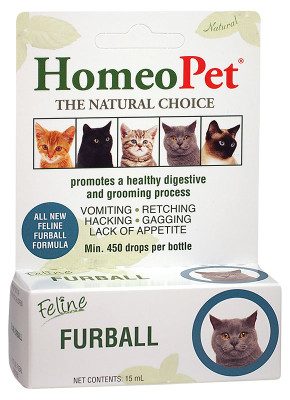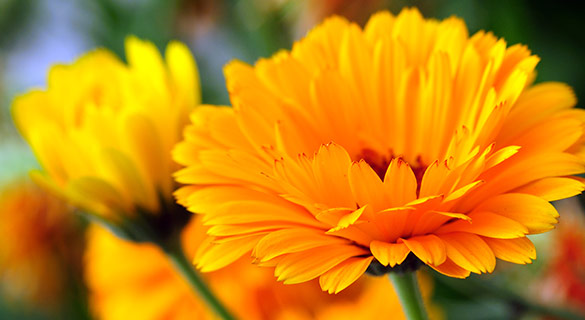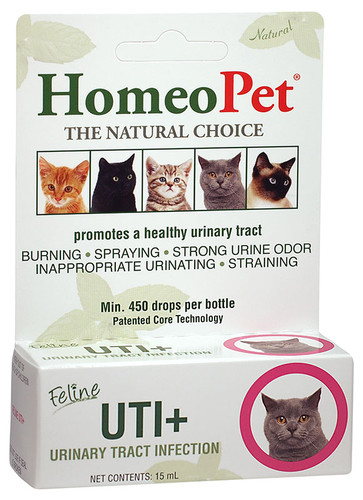
Ingredients – Feline UTI+
Aconitum Napellus 200c
(Monkshood)
Aconitum napellus is a species of flowering plant in the genus Aconitum of the family Ranunculaceae, native and endemic to western and central Europe. It is an herbaceous perennial plant growing to 1 m tall, with hairless stems and leaves.
Apis Mellifica 6c
(Honey Bee)
The western honey bee or European honey bee (Apis mellifera) is the most common of the 7–12 species of honey bee worldwide. The genus name Apis is Latin for “bee”, and mellifera is the Latin for “honey-bearing”, referring to the species’ production of honey for the winter.
Argentum Nitricum 30c
(Silver Nitrate)
Silver nitrate is an inorganic compound with chemical formula AgNO ₃. This compound is a versatile precursor to many other silver compounds, such as those used in photography. It is far less sensitive to light than the halides.
Arnica Montana 6c
(Leopard’s Bane)
Arnica montana, also known as wolf’s bane, leopard’s bane, mountain tobacco and mountain arnica, is a moderately toxic ethnobotanical European flowering plant in the sunflower family. It is noted for its large yellow flower head.
Arsenicum Album 6c
(White Oxide of Arsenic)
In homeopathy, arsenicum album is a solution prepared by diluting aqueous arsenic trioxide generally until there is little or no arsenic remaining in the solution.
Avena Sativa 4x
(Common Oat)
The oat, sometimes called the common oat, is a species of cereal grain grown for its seed, which is known by the same name. While oats are suitable for human consumption as oatmeal and rolled oats, one of the most common uses is as livestock feed.
Belladonna, 30c
(Deadly Nightshade)
Atropa belladonna, commonly known as belladonna or deadly nightshade, is a perennial herbaceous plant in the nightshade family Solanaceae, which includes tomatoes, potatoes, and aubergine. It is native to Europe, North Africa, and Western Asia.
Benzoicum Acidum 6c
(Benzoic Acid)
Benzoic acid, C₇H₆O₂, is a colorless crystalline solid and a simple aromatic carboxylic acid. The name is derived from gum benzoin, which was for a long time its only known source.
Berberis Vulgaris 4x
(Barberry)
Berberis, commonly known as barberry, is a large genus of deciduous and evergreen shrubs from 1–5 m tall, found throughout temperate and subtropical regions of the world.
Calcium Phosphate 30c
(Calcium Phosphate)
Calcium phosphate is a family of materials and minerals containing calcium ions together with inorganic phosphate anions. Some so-called calcium phosphates contain oxide and hydroxide as well. They are white solids of nutritious value.
Calendula Officinalis 4x
(Pot Marigold)
Calendula officinalis, the pot marigold, ruddles, common marigold or Scotch marigold, is a plant in the genus Calendula of the family Asteraceae.
Cantharis Vesicatoria 6x, 6c, 30c, 200c
(Spanish Fly)
Spanish fly is an emerald-green beetle, Lytta vesicatoria, in the blister beetle family. It and other such species were used in preparations offered by traditional apothecaries, often referred to as Cantharides or Spanish fly.
Causticum 6c, 30c
(Potassium Hydrate)
Potassium hydroxide is an inorganic compound with the formula KOH, and is commonly called caustic potash. Along with sodium hydroxide (NaOH), this colorless solid is a prototypical strong base.
Chimaphila Umbellata 30c
(Pipsissewa)
Chimaphila umbellata, the umbellate wintergreen, pipsissewa, or prince’s pine, is a small perennial flowering plant found in dry woodlands, or sandy soils. It is native throughout the cool temperate Northern Hemisphere.
Copaiva 7x
(Balsam of Copaiva)
Copaifera is a genus of flowering plants in the legume family, Fabaceae. The scientific name means “copal-bearer”, since economically important resins and essential oils can be acquired from them.
Echinacea Angustifolia 4x
(Purple Cone-flower)
Echinacea purpurea is a North American species of flowering plant in the sunflower family. It is native to eastern North America.
Epigaea Repens 4x
(Gravel Weed)
Epigaea repens – known as mayflower or trailing arbutus – is a low, spreading shrub in the Ericaceae family. It is found from Newfoundland to Florida, west to Kentucky and the Northwest Territories.
Equisetum Hyemale 4x
(Horse Tail)
Equisetum hyemale, commonly known as rough horsetail, scouring rush, scouringrush horsetail and in South Africa as snake grass, is a perennial herb in the fern Division Pteridophyta.
Equisetum Hyemale 6x
(Horse Tail)
Equisetum hyemale, commonly known as rough horsetail, scouring rush, scouringrush horsetail and in South Africa as snake grass, is a perennial herb in the fern Division Pteridophyta.
Ferrum Phosphoricum, 12x
(Phosphate or Iron)
Iron(III) phosphate, also ferric phosphate, is the inorganic compound with the formula FePO₄. Several related materials are known, including four polymorphs of FePO₄ and two polymorphs of the dihydrate FePO₄·(H₂O)₂.
Gelsemium sempervirens 30c
(Yellow Jasmine)
Gelsemium sempervirens is a twining vine in the family Gelsemiaceae, native to subtropical and tropical America: Honduras, Guatemala, Belize, Mexico, and southeastern and south-central United States.
Graphites naturalis 30c
(Black Lead)
Graphite, archaically referred to as plumbago, is a crystalline allotrope of carbon, a semimetal, a native element mineral, and a form of coal. Graphite is the most stable form of carbon under standard conditions.
Hydrangea Arborescens 4x
(Seven-barks)
Hydrangea arborescens, commonly known as smooth hydrangea, wild hydrangea, or sevenbark, is a species of flowering plant in the family Hydrangeaceae.
Hydrastis Canadensis 5x
(Golden Seal)
Goldenseal, also called orangeroot or yellow puccoon, is a perennial herb in the buttercup family Ranunculaceae, native to southeastern Canada and the eastern United States. It may be distinguished by its thick, yellow knotted rootstock.
Ignatia Amara 30c, 200c
(St. Ignatius Bean)
Strychnos ignatii is a tree in the Loganiaceae family, native to the Philippines, particularly in Catbalogan and parts of China.
Kali muriaticum 12x
(Potassium Chloride)
Potassium chloride is a metal halide salt composed of potassium and chlorine. It is odorless and has a white or colorless vitreous crystal appearance. The solid dissolves readily in water and its solutions have a salt-like taste.
Lachesis muta 30c
(Bushmaster Snake)
Lachesis muta is a venomous pit viper species found in South America. Two subspecies are currently recognized, including the nominate subspecies described here.

Marigold (Calendula officinalis)
Safe, Gentle, All Natural liquid dosing medicines for your best friend.
Lycopodium clavatum 12x, 30c
(Club Moss)
Lycopodium is a genus of clubmosses, also known as ground pines or creeping cedar, in the family Lycopodiaceae, a family of fern-allies.
Merc Sol/Mercurius Vivus 30c
(Mercury)
Mercury is a chemical element with symbol Hg and atomic number 80. It is commonly known as quicksilver and was formerly named hydrargyrum.
Natrum Muriaticum 30c
(Common Salt)
Sodium chloride, also known as salt, is an ionic compound with the chemical formula NaCl, representing a 1:1 ratio of sodium and chloride ions.
Nux Vomica 30c, 200c
(Poison-nut)
Strychnos nux-vomica, the strychnine tree, also known as nux vomica, poison nut, semen strychnos, and quaker buttons, is a deciduous tree native to India, and southeast Asia.
Pareira Brava 6x
(Virgin-Vine)
The pear tree brava ( Pyrus cordata , Desv. ) Is a thorny tree of the sort Pyrus , of the family of rosáceas.
Passiflora incarnata 4x
(Passion flower)
Passiflora incarnata, commonly known as maypop, purple passionflower, true passionflower, wild apricot, and wild passion vine, is a fast-growing perennial vine with climbing or trailing stems.
Petroselinum Sativum 4x
(Parsley)
Parsley or garden parsley is a species of flowering plant in the family Apiaceae, native to the central Mediterranean region, naturalized elsewhere in Europe, and widely cultivated as an herb, a spice, and a vegetable.
Phosphorus 6c, 30c
(Phosphorus)
Phosphorus is a chemical element with symbol P and atomic number 15. As an element, phosphorus exists in two major forms, white phosphorus and red phosphorus, but because it is highly reactive, phosphorus is never found as a free element on Earth.
Plumbum Aceticum 30c
(Acetate of Lead)
Lead(II) acetate, also known as lead acetate, lead diacetate, plumbous acetate, sugar of lead, lead sugar, salt of Saturn, or Goulard’s powder, is a white crystalline chemical compound with a sweetish taste.
Pulsatilla Nigricans 30c
(Pasque flower)
Pulsatilla pratensis is a species of the genus Pulsatilla, native to central and eastern Europe, from southeast Norway and western Denmark south and east to Bulgaria.
Sabal Serrulatum 6x
(Saw Palmetto)
Serenoa repens, commonly known as saw palmetto, is the sole species currently classified in the genus Serenoa. It is a small palm, growing to a maximum height around 7–10 ft.
Sarsaparilla Officinalis 30c
(Wild Liquorice)
Glycyrrhiza lepidota is a species of Glycyrrhiza native to most of North America, from central Canada south through the United States to California, Texas and Virginia, but absent from the southeastern states.
Scutellaria Lateriflora 4x
(Skullcap)
Scutellaria is a genus of flowering plants in the mint family, Lamiaceae. They are known commonly as skullcaps.
Sepia officinalis (succus) 6c, 30c, 200c
(Cuttlefish Ink)
The common cuttlefish is native to at least the Mediterranean Sea, North Sea, and Baltic Sea, although subspecies have been proposed as far south as South Africa. It lives on sand and mud seabeds and can tolerate brackish water conditions.
Solidago Virgaurea, 4x
(Goldenrod)
Solidago virgaurea is an herbaceous perennial plant of the family Asteraceae. It is widespread across most of Europe as well as North Africa and northern, central, and southwestern Asia. It is grown as a garden flower with many different cultivars.
Staphysagria 6c, 30c
(Stavesacre)
Delphinium staphisagria is a species of Delphinium, or larkspur, of the family Ranunculaceae. This plant is also known as lice-bane or stavesacre.
Stramonium 30c
(Stink-weed)
Datura stramonium, known by the English names jimsonweed or devil’s snare, is a plant in the nightshade family. It is believed to have originated in Mexico, but has now become naturalized in many other regions.
Sulphur 12x
(Brimstone. Sublimed Sulphu)
Sulfur or sulphur is a chemical element with symbol S and atomic number 16. It is abundant, multivalent, and nonmetallic. Under normal conditions, sulfur atoms form cyclic octatomic molecules with a chemical formula S₈.
Terebinthinia Oleum 6c
(Turpentine)
Turpentine is a fluid obtained by the distillation of resin obtained from live trees, mainly pines. It is mainly used as a solvent and as a source of materials for organic synthesis.
Thlapsi Bursa 4x
(Shepherd’s Purse)
Capsella bursa-pastoris, known by its common name shepherd’s purse because of its triangular flat fruits, which are purse-like, is a small annual and ruderal flowering plant in the mustard family Brassicaceae that grows up to 0.5 m tall.
Thuja Occidentalis 30c
(Arbor Vitae)
Thuja is a genus of coniferous trees in the Cupressaceae. There are five species in the genus, two native to North America and three native to eastern Asia. The genus is monophyletic and sister to Thujopsis.
Uva Ursi 4x
(Bearberry)
Bearberries are three species of dwarf shrubs in the genus Arctostaphylos. Unlike the other species of Arctostaphylos, they are adapted to Arctic and Subarctic climates, and have a circumpolar distribution.
Valeriana officinalis 4x
(Valerian Root)
Valerian (Valeriana officinalis, Caprifoliaceae) is a perennial flowering plant native to Europe and Asia. In the summer when the mature plant may have a height of 1.5 metres (5 ft), it bears sweetly scented pink or white flowers that attract many fly species, especially hoverfliesof the genus Eristalis.






